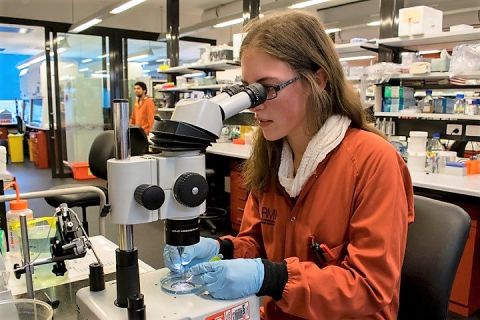Keeping pace with white blood cells

Keeping pace with white blood cells
Our bodies are always on alert. Every day, from the day we are born, our immune system recognises potential threats and seeks to destroy abnormal cells and bacteria, keeping us healthy.
Our white blood cells are constantly patrolling the body, to identify foreign microbes and abnormal cells, before initiating their defence mechanisms.
Neutrophils, a particular type of white blood cell, are the first cells to migrate to the sight of an infection or injury, and are one of the most motile cells types in the body. They are often called the first responders of the immune system.

When this early responder system doesn’t work well, is when we suffer the effects of infection and illness particularly cancer.
Harriet Manley, a 22 year old PhD student working at ARMI, is investigating neutrophils in zebrafish to see what makes cells motile as she believes this will help us better understand the immune response. It may also reveal clues as to how cancer cells gain motility and spread through our body.
‘Understanding the biology of neutrophils in zebrafish offers scientists an understanding of the immunity and infection fighting behaviour of white blood cells in humans as zebrafish and humans are genetically very similar, she said.
Neutrophils are a key component of the inflammatory response: they are incredibly good at moving through the body to infection, and have a large arsenal of weapons to fight off invaders.

In recent years the role of immune cells in particular neutrophils has been a matter of increasing interest.
“My PhD thesis is investigating how the nucleus affects neutrophil function.”
“It is thought that the human neutrophil nucleus contributes to the mobility of neutrophils through tissue spaces offering an insight how cells move, including the spread of cancer throughout tissues.
“Zebrafish are an excellent animal model in which to study the role of neutrophils and the role of the nucleus, as the fish are transparent,” Harriet said. “They are also fast growing and you can easily study cell types and cell structures by making them fluoresce in various colours.”
84% of genes known to be associated with human disease have a zebrafish counterpart, making zebrafish an important animal model in the study of human disease.
“ARMI has the largest zebrafish research colony in the southern hemisphere and this was one of the key reasons why I chose Monash to do my PhD”, offered Harriet.
